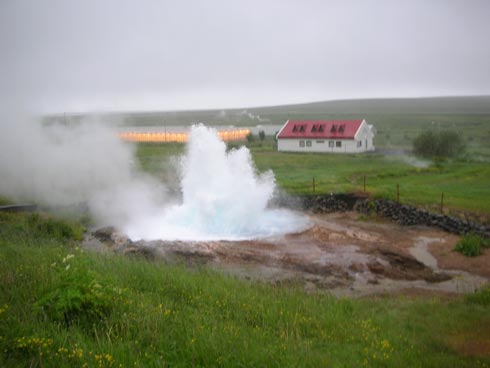Deep Vision: Big Energy from Way, Way Down
Today, typical geothermal wells are about 2.5 km in depth, produce steam at about 300 degrees Celsius and generate about 4-7 megawatts (MW) of electricity. In Iceland, a project is underway to drill almost twice that deep and potentially produce almost ten times that much energy.
It is estimated that producing steam from a well
penetrating a reservoir hotter than 450 degrees Celsius -- at a rate of 0.67
cubic meters (24 cubic feet) per second could be enough to generate 40-50 MW
of electricity.
The main objective of the IDDP is to investigate whether it is even economically feasible to produce energy and chemicals from geothermal systems at supercritical conditions.

A typical geothermal drilling rig is shown above. Photo Credit: Robert Zierenberg, UC Davis
In order to determine the economic feasibility the companies must drill to depths of 4 to 5 km in order to reach temperatures of 400-600°C (750 - 1,100°F). It is estimated that producing steam from a well penetrating a reservoir hotter than 450°C — at a rate of 0.67 cubic meters (24 cubic feet) per second could be enough to generate 40-50 MW of electricity. If this proves correct, it could lead to a major step forward in the development of high-temperature geothermal resources worldwide.
Two UC Davis geologists, Peter Schiffman and Robert Zierenberg, along with professors from UC Riverside, Stanford, and University of Oregon are part of the project.


The images above show two geothermal wells. Photo Credit: Robert Zierenberg, UC Davis
The scientists plan to study the chemistry that occurs at high pressures and temperatures at these great depths. "We hope to understand the process of heat transfer when water reacts with hot volcanic rocks and how that changes the chemistry of fluids circulating at depth," Zierenberg said. "We know very little about materials under these conditions."
Currently Iceland generates more than half of its electrical power from geothermal energy. Hot water and steam from boreholes can be used to run turbines for electricity or directly to heat homes and businesses. Iceland meets the rest of its electricity needs from hydroelectric power, and imports fossil fuels only for transportation.

Geysers on an Icelandic farm. Photo Credit: Robert Zierenberg, UC Davis
The U.S. has lots of potential for geothermal energy generation, Zierenberg said. There are several plants in California, including the Geysers region in the north and at Mammoth Lakes. According to Zierenberg, although its share of energy generation in the state is small, the Geysers is the largest geothermal field in the world. There are also numerous abandoned oil and gas boreholes around the country — including in the Central Valley — that could potentially access hot water that could be used for space heating.
That would, however, require something of a cultural change. In Iceland, geothermal heating is used at a community level: hot water is pumped up and circulated around a town or neighborhood. Americans are more accustomed to individual power delivery, Zierenberg said.
The team expects to begin drilling in the summer of 2008.
For Further Information
 To subscribe or visit go to:
http://www.renewableenergyaccess.com
To subscribe or visit go to:
http://www.renewableenergyaccess.com